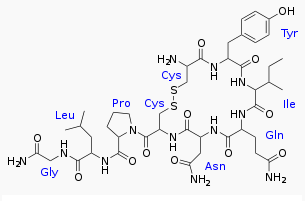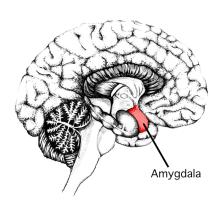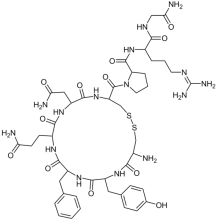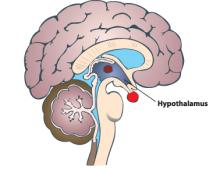Oxytocin, Vasopressin, and Human Social Behavior.
Oxytocin, Vasopressin, and Human Social Behavior.
Oxytocin (OT) is a peptide known to decrease anxiety/stress and increase relaxation, especially in social interactions. This peptide reduces the activity of the amygdala, which mediates situation of high fear (autonomic fear response). Test show that this hormone is also involved in trust, adult-infant attachment, helps in the immediate recognition and enhances memory of positive facial expressions compared to angry and neutral faces. It interacts in the limbic areas of the brain (the area that controls instinct, mood, basic emotions, and basic drives) and the amygdala. Oxytocin also seems to have an influence on the cortisol (steroid) levels, which are responsible for stress.
Figure 1:Oxytocin Structure


Arginine Vasopressin (AVP) is a sex-specific peptide that typically affects male social behaviors such as aggression, mating, stress responsiveness, scent marking, vigilance, arousal, anxiety, and activation. AVP interacts with the paraventricular nucleus of the hypothalamus that controls anxiety. It causes a heightened response to neutral and angry facial expressions as if they were threatening or aggressive. On the other hand, in women, as AVP levels increase, there is a friendlier perception of facial expressions.
Figure 3: Structure of AVP

Figure 4: Location of Hypothalamus

Disorders: Descriptions and hormone interaction
Autism Spectrum Disorder (ASD): abnormalities in communication, repetitive behaviors, and social interaction. Research has suggested that both OT and AVP influence ASD. Patients show reduced levels of OT in the plasma. The genes of their receptors have also been found to play an important role in social behavior, specifically the 3p25 region. Furthermore, systemic infusions (injections into the bloodstream) of OT have been shown to decrease repetitive behavior and improve emotion recognition.
Social Anxiety Disorder (SAD): Also known as social phobia, SAD is the most common disorder associated with high anxiety in social situations. Patients show heightened amygdala activity towards neutral faces, increasing anxiety. Intranasal administered OT has been found to suppress this fear activation in the amygdala and encourages a better central control of stress and anxiety in social interactions. Patients also exhibited better self-esteem and speech. However, these temporary results did not aid in long-term therapy.
Early Trauma and Association Disorders: Associated with over-anxiety and trauma regularly occurring within the first three years of infancy and that have an effect through adulthood. Early neglect impairs the central regulation of peptide release and/or synthesis that can contribute to negative consequences of childhood trauma. Childhood trauma interferes with the development of the neuropeptide system and affects receptor binding of OT and AVP, a leading cause of severe attachment disorders (child does not attach, bond, or trust his or her mother). Another disorder caused by the deregulation of AVP and OT is Borderline personality disorder (BPD), in which the individual has enhanced amygdala reactivity to negative scenes and negative/neutral expressions.
http://www.focusas.com/Attachment.html
https://health.google.com/health/ref/Borderline+personality+disorder
Obsessive-compulsive Disorder (OCD)- Disorder characterized by compulsive behaviors, intrusive thoughts, fears of danger and contamination, and inability to deal with anxiety. Studies have shown that symptoms are related to alteration in AVP such that there is an elevated level of AVP in the plasma and CSF (Cerebrospinal fluid). High levels of OT have not been confirmed to have an influence. Studies have not been able to yield results of OT and AVP administration as a potential source of therapy.
Depression- Disorder characterized by sadness, hopelessness, worthlessness, and pessimism and that is often accompanied with behavioral changes and new sleeping/eating patterns. Studies have shown a reduced amount of plasma OT levels in depressed patients. It has also been suggested that plasma OT levels are related to an award dependency, which is accounted in social attachment and dependency of approval from others. Avpr-1a the gene of a receptor of AVP causes the activation of CRF (corticotropin releasing factor) neurons, a factor of depression. Data suggests that the disorder is related to excessive AVP function and that a treatment with its receptor antagonists may be effective. A connection with OT levels has not been proven.
https://health.google.com/health/ref/Major+depression
Schizophrenia- Mental condition which makes it difficult to differentiate real and unreal experiences and think logically. The condition is also described as having unusual emotional responses, and awkwardness in social situations. Although there have not been a lot of experiments conducted linking OT and AVP to schizophrenia, some studies have found high concentration of OT and neurophysin II, the carrier of OT in the hypothalamic-pituitary, in schizophrenic individuals. However, another study found that lower OT levels were associated with decreased facial emotion recognition. Yet another study revealed that lower OT levels is related to inhibiting trust interactions. It has also been found that elevated plasma AVP levels cause this disorder. As a possible treatment, neuroleptical drugs can reduce these symptoms as it can normalize AVP plasma levels.
Interesting Notes
Interestingly enough, AVP levels have been found to play a role in marriages and couple interaction. Males carrying a specific sequence in allele 334 reported lower marital quality, marital crisis, and threat of divorce. The gene contained in this allele codes for avpr-1a, a receptor for AVP. This pulls attention to this gene as one responsible for social disorders.
Therefore both OT and AVP research can be important in treatment of stress-related disorders and violence. Symptoms of disorders such as autism can also be alleviated through control of OT and AVP levels by increasing the patient’s comfort in social situation, bettering the understanding of intonation in speech, and by decreasing repetitive behaviors. Control of these levels can be achieved through the administration of OT and AVP. Studies show that patients administered intranasal OT and AVP respond better to the effects of these peptides than those that were administered the hormones through the veins by systemic infusion. Researches are searching for the effects of intranasal drugs and the possibility of integrating them in “psychological therapy” to treat patients. However there are still many clinical trials to be conducted.